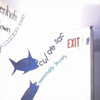 For all intents and purposes, this should have been a horrible mess.The liner notes, written by Cul De Sac muli-instrumentalist GlennJones, outline the tragedy that should have been quite clearly: theband shows up to do a live radio performance at Brandeis University andsuffer circumstances of Spinal Tap-ian proportions. There was verylittle space for the band to perform, they would not be able to see orhear the DJ during the production, and they had little time to soundcheck and would not be able to test their levels before the actualbroadcast began. Again, this should have guaranteed a horriblerecording. Instead, listening to it later, the band realized it was oneof their best live performances, and certainly worthy of release to afanbase rabid for new material. Having never heard Cul De Sac live, buthaving heard their records, it's also one of their best commitments totape. Sure it's sloppy in areas, as live performance can be, andseveral of the tracks go on much too long; but the band plays outadmirably, vibrantly, and without compromise. After all, they thoughtthis would be horrible from the outset. So they pull out the stops andlet loose with a series of tracks that suck you in and drone you out.There are moments of pure melodic beauty on 'Frozen in Fury on the Roofof the World,' dischordant beeps and steady rhythms meeting on thetitle track, the near-hypnotic shuffle of 'Flying Music from Faust,'and slow, deliberate marches to close the disc on 'Blue in E.' The bandruns the gamut, and they're better having survived it. Ultimately, withtwo albums in the works—a soundtrack and a studio album of original newmaterial - these recordings show promise for the direction Cul De Sacis headed towards, as well as serving as the best representation, bytheir own admission, of what the band is about. Sometimes it's prettysurprising what glory can be gained out of utter despair.
For all intents and purposes, this should have been a horrible mess.The liner notes, written by Cul De Sac muli-instrumentalist GlennJones, outline the tragedy that should have been quite clearly: theband shows up to do a live radio performance at Brandeis University andsuffer circumstances of Spinal Tap-ian proportions. There was verylittle space for the band to perform, they would not be able to see orhear the DJ during the production, and they had little time to soundcheck and would not be able to test their levels before the actualbroadcast began. Again, this should have guaranteed a horriblerecording. Instead, listening to it later, the band realized it was oneof their best live performances, and certainly worthy of release to afanbase rabid for new material. Having never heard Cul De Sac live, buthaving heard their records, it's also one of their best commitments totape. Sure it's sloppy in areas, as live performance can be, andseveral of the tracks go on much too long; but the band plays outadmirably, vibrantly, and without compromise. After all, they thoughtthis would be horrible from the outset. So they pull out the stops andlet loose with a series of tracks that suck you in and drone you out.There are moments of pure melodic beauty on 'Frozen in Fury on the Roofof the World,' dischordant beeps and steady rhythms meeting on thetitle track, the near-hypnotic shuffle of 'Flying Music from Faust,'and slow, deliberate marches to close the disc on 'Blue in E.' The bandruns the gamut, and they're better having survived it. Ultimately, withtwo albums in the works—a soundtrack and a studio album of original newmaterial - these recordings show promise for the direction Cul De Sacis headed towards, as well as serving as the best representation, bytheir own admission, of what the band is about. Sometimes it's prettysurprising what glory can be gained out of utter despair.
samples:
Read More

